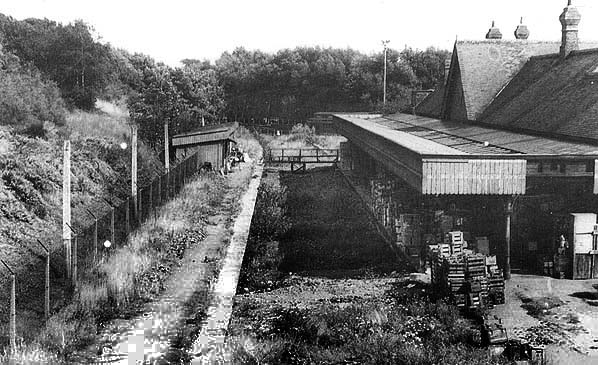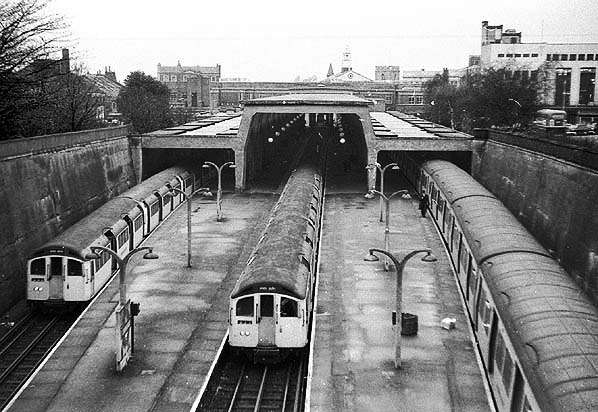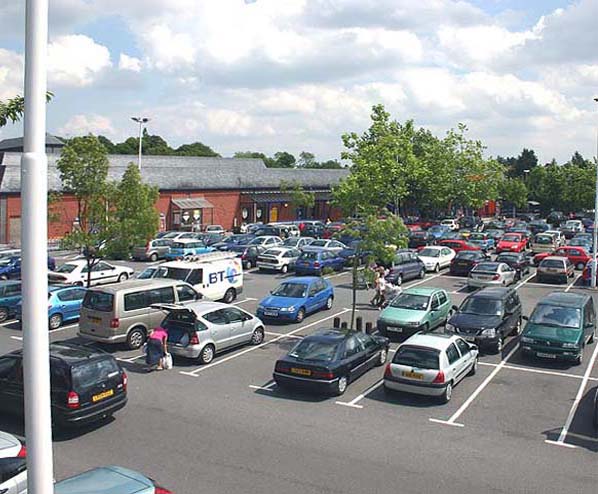
[Source: Nick Catford] Uxbridge Belmont Road Station: Gallery 3
1934 - July 2005 old25.jpg) Belmont Road booking hall and ticket office in 1934, the year following the formation of London Transport. The meaning of the pattern in the floor, if indeed it was a deliberate pattern and had a meaning, is not known. The design of the roof and its trussing is of note but otherwise the general design is typical of British railway stations of the time with the ticket windows, which could be opened and closed as required, the clock which in this case was a drop dial and the plethora of notices. None of the notices are readable unfortunately although that standing on the floor appears to display timetables. The apparently crudely drawn circle towards its bottom is in fact a roundel. There is another notice, barely visible on the matchboard panels to the immediate left of the Cloak Room door. 'Cloak Room' is a now largely obsolete term for what we would today call a Left Luggage store. Electric lighting is present (this station never had gas lighting) and the central of the three lights visible appears to have been the subject of a slightly bodged twin bulb experiment. Electric light bulbs of this era were not as efficient as those of today and were little better than gas lighting. These early bulbs would fail very quickly unless left powered-up constantly and this may have been the reason for the twin bulb experiment; the bulbs would have been wired in parallel so if one failed the other would, hopefully, keep going. Outside, behind the parked motor car and also through the window can be seen part of Alfred Button's extensive 'Metropolitan Depot' This company is briefly described elsewhere along with photographs of some of its road vehicles.
Photo from London Transport Museum old8.jpg)
If Belmont Road station has the appearance of a through station that is because a through station is what it was intended to be. The plan was to continue the line some fourteen miles to High Wycombe but no work is known to have been done and this part of the scheme was abandoned. The route this extension would have taken is unclear although it would probably have been via Stoke Poges before joining what is now the Chiltern Main line somewhere near Beaconsfield. This view dates from April 1934, some nine months after the creation of the London Passenger Transport Board (London Transport or LT for short). Note the early form of roundel on the left and the Metropolitan Railway 'diamond' style device on the right. These latter had white letters on a blue bar against a red diamond, the whole being mounted, where running-in boards were used, on a white background. Photograph suggests the station was originally oil lit and probably as a temporary expedient but by the time of this photograph electric lighting had been installed. Note the locomotive release; this would have been used regularly during the initial six month period of steam operation but subsequently it would have been rarely used. The houses in the background are on Belmont Road and as of October 2023 are still standing. The gap, seen above the Up platform building, marks the junction with Mead Road.
Photo from London Transport Museum old9.jpg) Taken in April 1934, the view faces east north-east from behind the bufferstops. The locomotive release is clearly seen and the signal box stands in the background. This 'box had a 35-lever mechanical frame and was closed by London Transport on 3 December 1938, the day prior to official closure of the station. From opening block working was in place but the line was converted to automatic and semi automatic signalling as follows: Uxbridge to Ruislip on 20 July 1930 and Ruislip to Rayners Lane on 24 August 1930. Note the positive current rails positioned at the platform side of the tracks. The northernmost siding in the goods yard, passing directly behind the signal box, was also electrified and presumably for use as a stabling siding. Note that the cast iron lamp posts which had stood on the Up platform, left, have been replaced by what are presumably wooden posts.
Photo from London Transport Museum old26.jpg) Believed taken in 1937, a train of 'T Stock' arrives at Belmont Road. This is the only photograph which has come to light showing a close-up of the signal box and also one of just two showing colour-light signals at Belmont Road, the other being one of the April 1934 views in which they are just discernible in the distance. This signal box was given the code letter 'W' which was transferred to the 'box at the new station in 1938, which latter 'box closed on 3 May 1987 by which time it was coded 'MW'. The notice at the bottom of the platform ramp warns firstly, passengers not to attempt to cross the line and secondly, warns staff not to step on the live rail. 'T Stock' was a London Transport designation. These trains first appeared in 1927 and the Metropolitan Railway designated them 'MV' (vacuum brakes) and 'MW' (air brakes) which meant the two types were incompatible. London Transport soon set about standardising the fleet, resulting in the 'T Stock' Some cars were wooden bodied, some steel panelled, some running with adapted 'Dreadnought' trailers and some running with purpose built trailers. As with much Underground stock, the full early history is complicated and the aforegiven has to suffice for an image caption. 'T Stock' last ran in passenger service in October 1962 but two Driving Motor cars were converted into an Electric Sleet Locomotive numbered ESL118A/B having been cars 2758 and 2749 respectively. For many years this twin ESL was a familiar sight stabled at Rickmansworth until it was finally withdrawn in 1983. Both cars have survived into preservation.
Photo from Jim Lake collection 
In
the 1950's the station remained largely intact with the station building being used was used by Alfred Button and Sons a local grocer as a warehouse. The track bed has been partially filled up to platform level.
Photo by John Smith 1.jpg)
In October 1962, Alfred Button and Sons still occupied the station building although by this time the company was part of the Booker Group. The area beneath the canopy has been enclosed and the trackbed has been further infilled with no platform edges visible in this view. A number of Alfred Button's delivery vehicles can be seen. Click here for three further pictures of Alfred Button's vehicles.
Photo by John Cosford from his Flickr photostream 3.jpg)
In February 1968 a new canteen for Booker Belmont (formerly Alfred Button and Sons) was under construction between Belmont Road and the station - this building has now been demolished. The waiting room was surprisingly still standing. The timber enclosing the canopy appears to have been removed. The line into the new Uxbridge station is seen in the background.
Photo by Nick Catford 4.jpg) By March 1969 the station building had been demolished although the platform edge can be seen in this view. Note all the Budgen delivery vehicles in the background. Budgen now occupied the former Alfred Button warehouse. Budgen, Alfred Button & Co and Booker Belmont are all part of the Booker Group, a subsidiary of Tesco. The new canteen building seen in the picture above is bottom right.
Photo by Nick Catford 
The 'new' station
at Uxbridge in March 1969.
Photo
by Nick Catford
 The site of the station is now ocupied by a car park for Sainsbury's supermarket in York Road seen here in July 2005.
Photo
by Nick Catford
 Home Page Home Page
|


